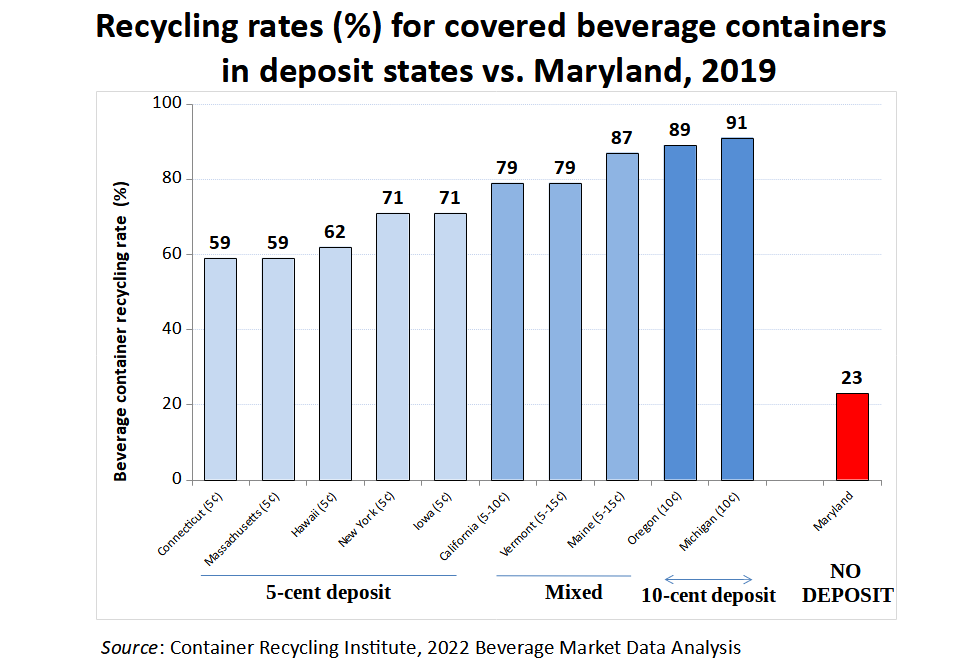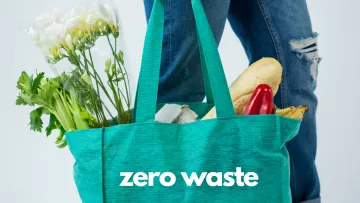
Join the Zero Waste Team
Join us in Reducing, Reusing, and Recycling
to conserve resources, reduce solid waste,
and protect the environment!
Did you know that...
- Maryland generates nearly 14 million tons of solid waste annually?[1] About two-thirds of municipal solid waste is paper, plastic, food scraps, and yard waste.[2]
- Landfills release methane – a potent greenhouse gas – from anaerobic decomposition of organic material. They can also contaminate groundwater.
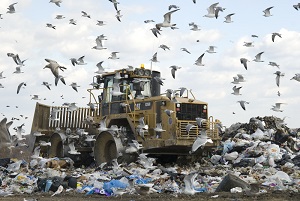
- Only a quarter (25%) of the 5.5 billion beverage containers sold in Maryland in 2021 were recycled and reused in some other form. More than 4 billion containers were wasted – left in the environment, in landfills or as litter, or incinerated. In states with container deposit programs, the recycling and reuse rate is three times higher!
- The recycling rate for paper is only about 50%, and for plastic and food scraps is less than 10%. What is not recycled is landfilled, incinerated, or litters our roadways and waterways.
 Support a Maryland beverage container deposit program to reduce litter and plastic pollution!
Support a Maryland beverage container deposit program to reduce litter and plastic pollution!
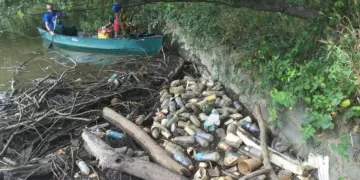
Each year in Maryland, about 5.5 billion bottles and cans are sold, but only 1.4 billion are currently recycled. The rest are incinerated, buried in landfills, or littered in our waterways and along roadways. Ten states in the U.S., covering about 90 million people, have long-standing, successful, and cost-effective beverage container deposit programs that incentivize recycling and deter littering by refunding a small deposit for each container to those who return them for recycling.
The Maryland Beverage Container Recycling Refund and Litter Reduction Program (a.k.a. the Maryland "Bottle Bill") would require a 10- or 15-cent deposit on single-use beverage containers that is refunded when the containers are returned for recycling. The program would:
- Boost Maryland’s recycling rate for beverage containers, from 25% to more than 90%;
- Divert 3.6 billion beverage containers annually from landfills, incinerators, and the environment;
- Produce high-quality, food grade materials for recycling into new beverage containers;
- Yield substantial cost savings for local governments;
- Encourage investments in reusable and refillable containers;
- Create new jobs in Maryland; and
- Reduce greenhouse gases associated with producing new containers from virgin materials.
The fact sheet below describes the program. The "Road Map" is an unofficial summary document that will help you navigate the 2024 bill (HB 735/SB 642).
- Fact Sheet on the Maryland Bottle Bill
- Maryland Beverage Container Recycling Refund and Litter Reduction Act (HB 735 / SB 642)
- Unofficial "Road Map" to navigate the 2024 bill (HB 735/SB 642)
- February 2024 Virtual Rally for a Maryland Bottle Bill! (video)
- Resources
- Deposit Return Systems Reduce Litter (Reloop and CRI Fact Sheet 2021)
- Deposit Return Systems Generate Cost Savings for Municipalities (Reloop Fact Sheet 2021)
- Deposit Return Systems Create More Jobs (Reloop Fact Sheet 2021)
- The Impact of Deposit Return Systems on Beverage Sales (Reloop and CRI research, 2023)
- The Big Beverage Playbook for Avoiding Responsibility (Conservation Law Foundation, 2022)
- Exposed: How Coke Killed the Refillable Bottle (12-minute documentary, The Story of Stuff Project)
 Support Plastic Post-Consumer Recycled Content to reduce plastic waste, increase recycling, and replace virgin plastic in new containers!
Support Plastic Post-Consumer Recycled Content to reduce plastic waste, increase recycling, and replace virgin plastic in new containers!
The plastic bottle you toss in the recycling bin most likely won't return as a new bottle. Producers prefer using new plastic because it is cheaper than using plastic recycled from used containers. Substituting recycled PET (polyethylene terephthalate) plastic for new PET would reduce the amount of fossil fuels needed in production of new containers and could lower the energy requirements and resulting pollution by as much as 75%. Five U.S. states and the European Union have enacted legislation to mandate recycled content for new plastic containers.
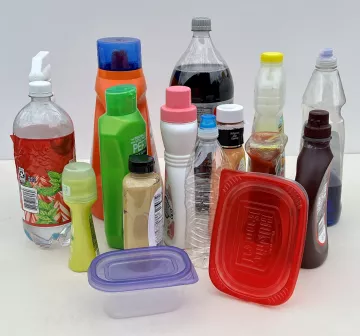
The Plastic Post-Consumer Recycled Content bill requires producers selling plastic containers in Maryland to increase the recycled content in plastic beverage containers to 50% by 2033, in rigid plastic food containers to 40% by 2034, and in rigid plastic containers for personal care and household cleaners to 35% by 2035. If passed, it will:
- Reduce production of new plastic and its environmental damage
- Stimulate markets for recycled plastic, especially food-grade recycled plastic
- Incentivize producers to redesign their containers to be more recyclable
- Reduce wasted plastic in landfills, incinerators, and the environment
The Plastic Post-Consumer Recycled Content Bill will be reintroduced in the 2025 Maryland General Assembly by Del. Jen Terrasa.

Support Transparency and Accountability for Disposal of Synthetic Turf Fields!
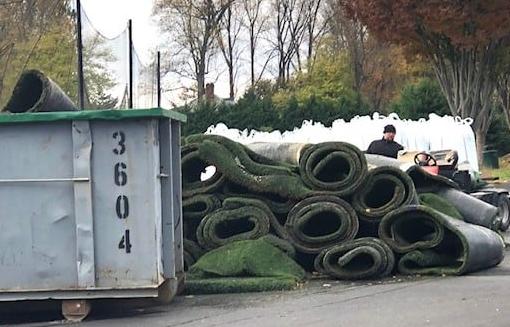
Synthetic turf fields have an 8-10 year average lifetime and produce a large volume of waste, much of it toxic. An average field of 80,000 square feet is comprised of 40,000 pounds of mixed plastic turf and 400,000 pounds of infill – usually tire waste and silica sand. The infill alone for one field amounts to 400 cubic yards, the equivalent of almost fourteen 30-cubic yard dumpsters. The fate of this enormous amount of plastic waste and infill is difficult, if not impossible to track. Read more
- Sierra Club Inventory of Maryland's Synthetic Turf Fields: Learn about the number of fields and the waste they will generate statewide and in your jurisdiction, when they are replaced over the next decade. The inventory will be periodically updated.
- Methodology and results
- Summary of Maryland's synthetic turf fields, ownership, and projected waste, by County, as of Jan 1, 2024
- List of Maryland synthetic turf fields by county, as of Jan 1, 2024
- Please help us by reporting: 1) a new field, 2) information or correction on a listed field, or 3) a replaced field.
- Support the 2024 Synthetic Turf Chain of Custody Bill (HB 457)! The Synthetic Turf Chain of Custody bill passed the House of Delegates twice, in 2022 and 2023, but was stalled in the Senate. Contact your legislators to get this bill over the finish line in 2024!
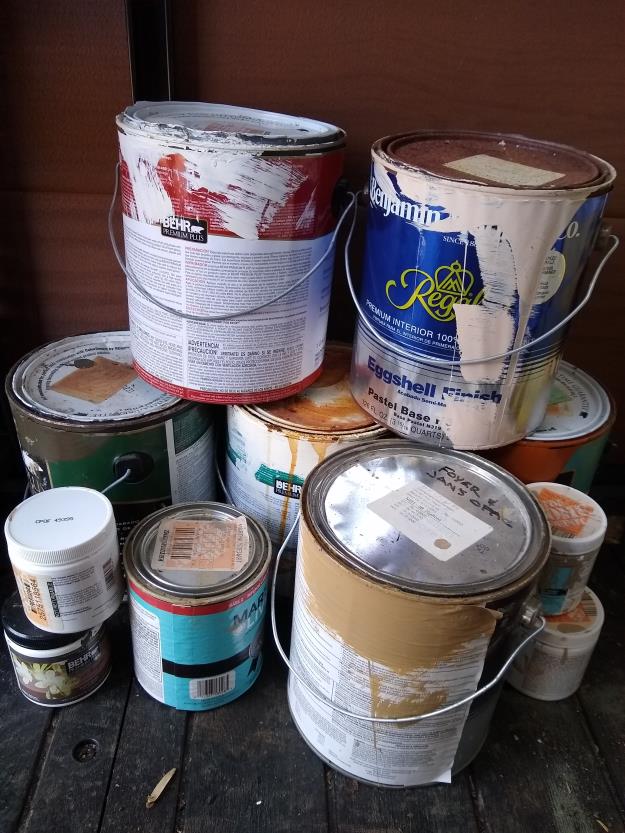 Maryland passed the Paint Stewardship Program in 2024!
Maryland passed the Paint Stewardship Program in 2024!
In 2024, Maryland joined eleven states and the District of Columbia in passing a Paint Stewardship Program. Once the Maryland program officially starts in 2026, Paint Care, a nonprofit representing all manufacturers that sell paint in the state, will offer drop-off sites throughout the state where the public can conveniently take leftover paint for donation, recycling, and proper disposal.Learn more about this program that requires extended producer responsibility for producers of architectural paint (latex and oil-based), to reduce waste, increase reuse and recycling, and save money for local governments!
- Webinar by Del. Regina Boyce and Heidi McAuliffe, Vice President, American Coatings Association
- Presentation by Heidi McAuliffe and Pamela Metz Kasemeyer
- The 2024 Paint Stewardship Bill – HB 1 (Del. Boyce), SB 325 (Sen. Brooks and Sen. West)
- Sierra Club Fact Sheet and Testimony
- What paint recycling does your Maryland county offer?
- PaintCare website
Reduce Single-Use Plastic
The world is facing a plastic pollution crisis, affecting climate change, the natural environment, and human health. Since it first came into widespread use after WWII, more than 10 billion tons of plastic has been produced. An estimated 30% is currently in use.[3] Of the plastic that has been discarded, only about 9% was recycled and 12% incinerated. The rest – an estimated 60% of all plastic ever produced – has been landfilled or left in the natural environment. About 40% of current annual plastic production is for packaging and single-use items (bags, bottles, straws, bags), used for only minutes but that last in the environment for centuries or more. Read more
Extended Producer Responsibility for Packaging
Extended Producer Responsibility (EPR) makes producers take responsibility for the end-of-life management of their products. There are 136 such programs in 33 states covering different types of products. View this 2021 webinar by John Hite of the Conservation Law Foundation’s Zero Waste Program to learn how EPR programs can reduce packaging, boost recycling rates, and reduce costs for local governments.
Since this webinar, four states (Maine, Oregon, California, Colorado) have passed laws requiring producer responsibility for packaging, although none are yet in operation. In 2023, the Maryland General Assembly passed, HB222, requiring the Maryland Department of the Environment to conduct a Needs Assessment, on the basis of which a Maryland packaging law can be designed. The Needs Assessment is scheduled for completion in 2024.
Chemical Recycling: False Solution to the Plastic Pollution Crisis
As the plastics industry gears up to increase production four-fold by 2050, it's now promoting "chemical recycling" (also referred to as "advanced recycling") as the solution to the plastic pollution problem, overcoming plastic recycling failures and creating a "circular economy" in plastic. However, the evidence to support these claims is scant. Read more
- Webinar and Presentation by Dr. Neil Tangri, Global Alliance for Incinerator Alternatives (GAIA), with comments by Del. Sara Love, sponsor of HB 21, "Ban on Chemical Conversion of Plastic" (2021)
- Fact Sheet and Sierra Club testimony (2021)
- FAQ
- GAIA (2020): All Talk and No Recycling: An Investigation of US “Chemical Recycling” Industry
- Greenpeace (2020): Deception by the Numbers: American Chemistry Council Claims about Chemical Recycling Investments Fail to hold up to scrutiny
- Beyond Plastics and IPEN (2023): Chemical Recycling: A Dangerous Deception
Maryland Says Goodbye to Foam Food Containers!
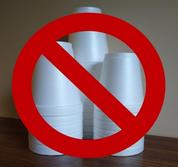 On July 1, 2020 Maryland became the first in the nation to implement a statewide ban expanded polystyrene (EPS) food containers. The new law bans the sale of EPS food service products – foam cups, plates, bowls, clamshells, trays, and other food or beverage containers – and prohibits food service businesses and schools from selling or serving food or beverages in these containers.[4] Read more
On July 1, 2020 Maryland became the first in the nation to implement a statewide ban expanded polystyrene (EPS) food containers. The new law bans the sale of EPS food service products – foam cups, plates, bowls, clamshells, trays, and other food or beverage containers – and prohibits food service businesses and schools from selling or serving food or beverages in these containers.[4] Read more
Help get the word out on the new foam ban!
- Handout - Maryland’s Ban on EPS Food Service Containers: What you need to know
- Local government contacts on the foam ban as of 11/13/20
- Webinar and presentation for counties on rolling out the foam ban
- Websites for local bans in Anne Arundel County, City of Baltimore, Montgomery County, and Prince George’s County
The Story of Plastic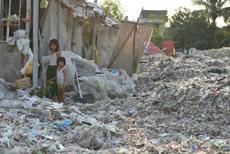
The Story of Plastic, a 95-minute documentary released on the 50th anniversary of Earth Day, takes a sweeping look at the man-made crisis of plastic pollution and the worldwide effect it has on the health of our planet and the people who inhabit it. Read more
- Panel discussion of "The Story of Plastic" for Maryland and local legislators, May 7, 2020
- Resources on Plastic Pollution Solutions, from the panelists
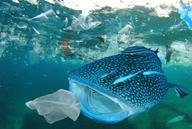
Statewide Plastic Bag Ban Nearly Passes Maryland’s 2020 General Assembly
The 2020 Plastics and Packaging Reduction Act, as introduced by Del. Brooke Lierman (HB209) and Sen. Malcolm Augustine (SB331), would have prohibited retailers from providing plastic carryout shopping bags to customers at the point of sale and required retailers to charge at least 10 cents for other carryout bags. It also would have established a working group to study and recommend actions to reduce plastic and single-use container waste in Maryland. Read more
[1] 13.9 million tons, CY2021 data: https://mde.maryland.gov/programs/land/RMP/Documents/MSWMaDR%20%2722.pdf
[2] 2016 Maryland Statewide Waste Characterization Study: https://mde.maryland.gov/programs/LAND/SolidWaste/Documents/2016%20Maryland%20Statewide%20WCS%20Study.pdf
[3] Geyer, R., J. R. Jameck, K. L. Law. 2017. “Production, use, and fate of all plastics ever made,” Science Advances 3, e1700782. Shares calculated off of 2015 estimates.
[4] In light of the closures during spring 2020 due the coronavirus epidemic, the deadline for food service businesses and schools to use up their stocks of EPS food containers was extended to October 1st by executive order of Gov. Hogan. However, the ban on retail sale of EPS food containers went into effect on July 1, 2020, per the legislation.
[5] The House and Senate bills were identical and had identical amendments; the links are to HB209.
Sierra Club's Zero Waste Policy and Guidance on Beverage Containers
This new guidance document makes the case for supporting beverage container deposit systems, lessons learned, and unacceptable substitutes, supplementing National Sierra Club's Zero Waste Policy.
